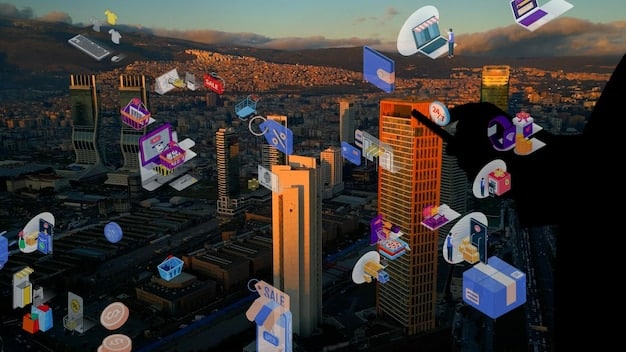Metaverse Investment: Opportunities and Risks for US Tech Enthusiasts

Decoding the Metaverse involves understanding the investment landscape, navigating potential opportunities, and recognizing the inherent risks for tech enthusiasts in the US market.
The metaverse, a digital frontier promising immersive experiences, presents both lucrative investment avenues and considerable risks for US tech enthusiasts. Decoding the Metaverse: Investment Opportunities and Risks for US Tech Enthusiasts requires a strategic approach, understanding its evolving nature, and assessing its potential impact on various sectors.
Understanding the Metaverse: A Primer for US Investors
The metaverse represents a significant shift in how we interact with technology and each other. For US investors, grasping its core concepts is the first step toward identifying worthwhile opportunities and mitigating potential pitfalls.
What Exactly is the Metaverse?
Defining the metaverse is an ongoing process, but essentially, it’s a network of persistent, shared, 3D virtual worlds. These worlds are accessed through various devices, allowing users to interact, create, and transact in a digital environment.
Think of it as a digital extension of our physical world, where people can socialize, work, play, and even own virtual assets. The key is immersion and interoperability across different platforms.

Key Components of the Metaverse
Several technologies and concepts underpin the metaverse, each playing a crucial role in its functionality and user experience. Understanding these components is essential for identifying viable investment opportunities.
- Virtual Reality (VR) and Augmented Reality (AR): These technologies provide the immersive experiences that define the metaverse, allowing users to interact with virtual environments and overlay digital information onto the real world.
- Blockchain and Cryptocurrencies: Blockchain technology enables secure and transparent ownership of digital assets within the metaverse, while cryptocurrencies facilitate transactions and create virtual economies.
- Non-Fungible Tokens (NFTs): NFTs represent unique digital assets, such as virtual land, avatars, and collectibles, providing verifiable ownership and scarcity in the metaverse.
- Artificial Intelligence (AI): AI can enhance the metaverse experience by creating realistic avatars, personalizing content, and automating tasks.
In essence, the metaverse leverages cutting-edge technologies to create persistent, shared digital environments with economic and social potential.
Investment Opportunities in the Metaverse for US Tech Enthusiasts
The metaverse is brimming with diverse investment opportunities, catering to various risk appetites and investment strategies. US tech enthusiasts can explore several promising avenues.
Direct Investment in Metaverse Platforms
Investing directly in companies building and operating metaverse platforms is one option. These platforms provide the infrastructure and user base for virtual experiences.
Consider companies involved in developing VR/AR hardware, creating virtual worlds, and providing metaverse-related services. However, it’s crucial to research their long-term viability and market positioning.
Investing in Metaverse-Related Technologies
Investing in companies developing technologies that enable the metaverse can be a strategic move. This includes firms specializing in blockchain, AI, cloud computing, and semiconductors.
- Blockchain Companies: These companies are developing the underlying infrastructure for secure transactions and digital asset ownership in the metaverse.
- AI Developers: AI is crucial for creating realistic avatars, personalizing experiences, and automating tasks within virtual worlds.
- Cloud Computing Providers: The metaverse requires significant computing power and storage, making cloud computing providers essential.
- Semiconductor Manufacturers: High-performance chips are needed to power VR/AR devices and handle the complex graphics of metaverse environments.
Focusing on essential enabling technologies can provide exposure to the metaverse’s growth without being directly tied to the success of specific platforms.

Potential Risks and Challenges for US Metaverse Investors
Investing in the metaverse is not without its risks. US tech enthusiasts must be aware of these challenges to make informed decisions and protect their investments.
Technological Hurdles and Adoption Rates
The metaverse is still in its early stages of development, and significant technological hurdles remain. Widespread adoption depends on overcoming these challenges and improving the user experience.
Latency issues, limited device capabilities, and the lack of compelling content can hinder adoption. Investors should monitor technological advancements and adoption rates closely.
Regulatory Uncertainty
The regulatory landscape surrounding the metaverse is still evolving, creating uncertainty for investors. Governments worldwide are grappling with how to regulate virtual worlds, digital assets, and user privacy.
Changes in regulations could impact the value of metaverse-related assets and the viability of certain business models. Investors should stay informed about regulatory developments and their potential implications.
Market Volatility and Speculation
The metaverse market is highly volatile and prone to speculation, which can lead to significant price swings. Investors should be prepared for potential losses and avoid making decisions based on hype.
- Price Volatility: The value of digital assets within the metaverse can fluctuate dramatically, making it a high-risk investment.
- Speculative Bubbles: Hype and excitement can drive prices to unsustainable levels, leading to market corrections and losses for investors.
- Scams and Fraud: The nascent nature of the metaverse makes it vulnerable to scams and fraudulent schemes.
Due diligence and a long-term investment perspective are essential for navigating the volatility of the metaverse market.
Navigating the Regulatory Landscape: US Considerations
Understanding the legal and regulatory aspects is crucial for US investors venturing into the metaverse. A clear understanding of these factors can help mitigate risks and ensure compliance.
Securities Laws and Digital Assets
The application of securities laws to digital assets within the metaverse is a complex issue. The SEC and other regulatory bodies are actively scrutinizing the classification of these assets.
Depending on their characteristics, some digital assets may be considered securities, requiring compliance with registration and disclosure requirements.
Data Privacy and Security Concerns
The metaverse raises significant data privacy and security concerns. The collection and use of personal data within virtual worlds are subject to privacy laws, such as the California Consumer Privacy Act (CCPA).
Investors and developers must prioritize data security and implement measures to protect user privacy. Failure to do so could result in legal liabilities and reputational damage.
Intellectual Property Rights
Protecting intellectual property rights within the metaverse is essential. Brands and creators need to safeguard their trademarks, copyrights, and patents in virtual environments.
Enforcement of intellectual property rights in the metaverse can be challenging due to its decentralized nature. However, legal frameworks are gradually evolving to address these issues.
Building a Diversified Metaverse Investment Portfolio
Diversification is a key strategy for managing risk in any investment portfolio, and the metaverse is no exception. US tech enthusiasts should consider diversifying their metaverse investments across different sectors and asset classes.
Investing Across Different Metaverse Sectors
Spreading investments across various metaverse sectors can mitigate the impact of any single sector’s underperformance. Consider allocating capital to platforms, enabling technologies, content creation, and virtual real estate.
Diversification reduces exposure to specific risks and increases the chances of capturing overall metaverse growth.
Balancing Risky and Conservative Investments
A balanced metaverse investment portfolio should include a mix of risky and conservative assets. High-growth potential investments, such as emerging metaverse platforms, can be balanced with more established technology companies.
This approach allows investors to participate in the upside potential of the metaverse while mitigating downside risks.
Long-Term Investing vs. Short-Term Trading
Consider a long-term investment horizon rather than short-term trading. The metaverse is still in its early stages, and its long-term potential is yet to be fully realized.
Patience and a focus on fundamental value can lead to more sustainable returns in the long run.
Future Trends and the Evolution of the Metaverse
Staying informed about future trends is crucial for US investors navigating the evolving metaverse landscape. Several key trends are shaping the future of virtual worlds.
Increased Interoperability and Open Standards
The future metaverse is likely to be characterized by increased interoperability and open standards. This will allow users and assets to move seamlessly between different virtual worlds.
Companies adopting open standards will be better positioned to thrive in a more interconnected metaverse.
Advancements in VR/AR Technology
Continued advancements in VR/AR technology will enhance the immersion and user experience within the metaverse. More lightweight, affordable, and high-performance devices will drive adoption.
Investors should monitor developments in VR/AR hardware and software to identify promising investment opportunities.
Integration with the Physical World
The metaverse is expected to become increasingly integrated with the physical world through AR overlays and location-based experiences. This will blur the lines between the digital and physical realms.
Companies developing solutions that bridge the gap between the metaverse and the physical world are likely to be well-positioned for future growth.
| Key Area | Brief Description |
|---|---|
| 💡 Metaverse Basics | Understanding the metaverse’s core components is critical for investors. |
| 💰 Investment Avenues | Explore direct investment or enabling technologies for metaverse growth. |
| ⚠️ Risks & Challenges | Be aware of technological hurdles, regulation, and market volatility. |
| ⚖️ Regulatory Issues | Understand laws on securities, data privacy, and IP rights in the metaverse. |
FAQ
▼
The metaverse is a digital realm blending virtual reality, augmented reality, and online social spaces. It attracts attention due to its potential to revolutionize entertainment, communication, and commerce.
▼
Opportunities include investing in metaverse platforms, virtual real estate, digital assets like NFTs, and companies developing VR/AR technologies essential for metaverse functionality.
▼
Risks include the unproven nature of metaverse projects, market volatility, regulatory uncertainties, high entry costs for virtual land, and potential security vulnerabilities in blockchain-based systems.
▼
Diversification strategies involve investing in various aspects of the metaverse, such as platforms, technologies, and digital assets, along with balancing exposure between established and emerging players.
▼
Future trends include enhanced interoperability between platforms, increased integration of AI, advancements in VR/AR technologies, and clearer regulatory frameworks to support metaverse development.
Conclusion
Decoding the Metaverse: Investment Opportunities and Risks for US Tech Enthusiasts requires a comprehensive understanding of emerging technologies, market dynamics, and regulatory landscapes. While the metaverse presents numerous avenues for investment, it’s crucial for US tech enthusiasts to approach this digital frontier with caution, informed decision-making, and a long-term perspective to navigate the complexities and capitalize on its potential.





